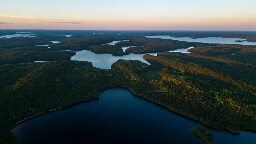Small lakes, big studies: what Ontario’s experimental lakes area teaches the world about water | The Narwhal



Known as the Institute for International Sustainable Development Experimental Lakes Area, the 27,000-hectare area is covered in thousands of little lakes set in bedrock and bordered by thick spruce and pine forests. It’s in Treaty 3 territory, and visitors who aren’t from an Indigenous community require a permit to use the lone gravel road that leads up to the water bodies. Together, the experimental lakes tell a story of the challenges facing Canada’s fresh water and provide a glimpse into what solutions might be possible.
They’re also of global importance: every year, data requests pour in from academics from around the world, making the experimental lakes a crucial research connection between bacterial pathogens in Spain to algae blooms in western Ontario and beyond.
It was here that scientists discovered what acid rain and phosphates did to fresh-water lakes (specifically the Great Lakes), which led to increased regulation on smoke stack emissions and a ban on phosphates in laundry detergent.
Canada's former PM Stephen Harper, a notorious anti-science right-wing leader, sought to shut this place down ... but thankfully it survived his stupidity.